The 2018 user's survey is closed, time for a look at the results. Several of the questions were also on the two past surveys, so we can start to look at historical trends as well.
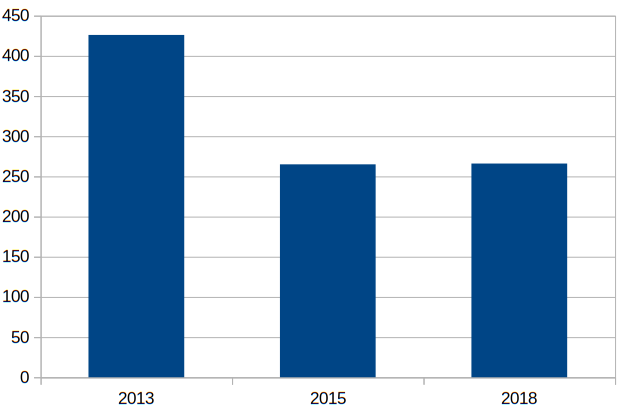
Very similar numbers of people responded in 2018 as in 2015. The 2013 survey remains a high water mark in participation. My thoughts on the 2015 survey participation level mostly still stand, although there has been a consistent downwards trend in Debian popcon since 2015.
Also interesting that several people skipped the first question on the survey, perhaps because it was a fairly challenging question? And later questions saw much higher response rates this time than in either of the previous surveys, thanks to improvements in the survey interface.
v7
v7 unlocked files are being used by 7% of users, pretty impressive uptake for a feature that has only been really finished for a couple of months. Direct mode is still used by 7% of users, while its v7 replacement of adjusted unlocked branches is only used by 1% so far. That's still some decent progress toward eliminating the need for direct mode.
command line vs assistant

Well that's plain enough isn't it? Although note that I myself have the assistant running in some repos all the time, but would of course vote "command line" since I interact with that much more.
Also notice that people who apparently don't use git-annex but wanted to fill out the survey anyway was the same for 2013-2015, but has now declined.
operating system
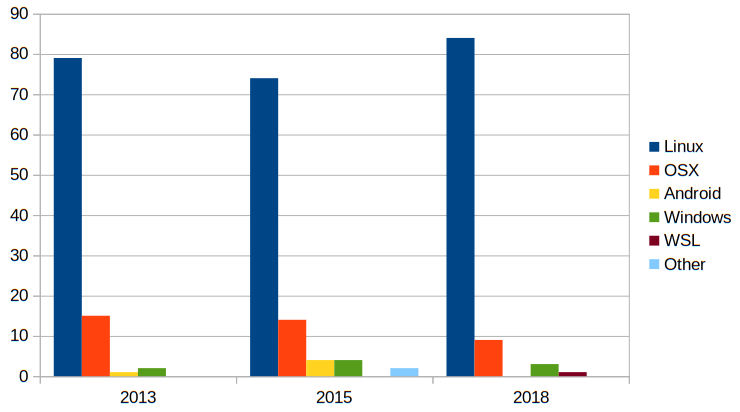
Android users have more or less gone away since I deprecated the app. I hope the termux integration brings some back.
how git-annex is installed
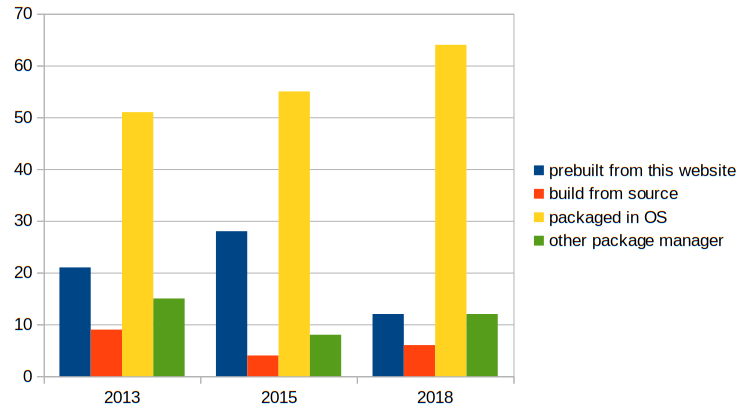
Good to see the increase in using git-annex packages from the OS or a third-party package manager.
missing/incomplete ports
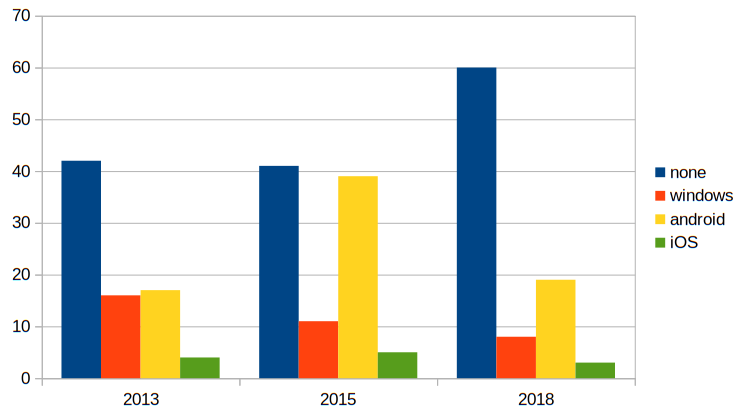
Good improvement here since 2015 with 60% now satisfied with available ports.
Worth noting that in 2013, 6% wanted a way to use git-annex on Synology NAS. That is possible now via the standalone linux tarball. This year, 2% wanted "Synology NAS (app store package)".
Also honorable mention to the anonymous person who rewrote git-annex in another language. You should release the code!
number of repositories
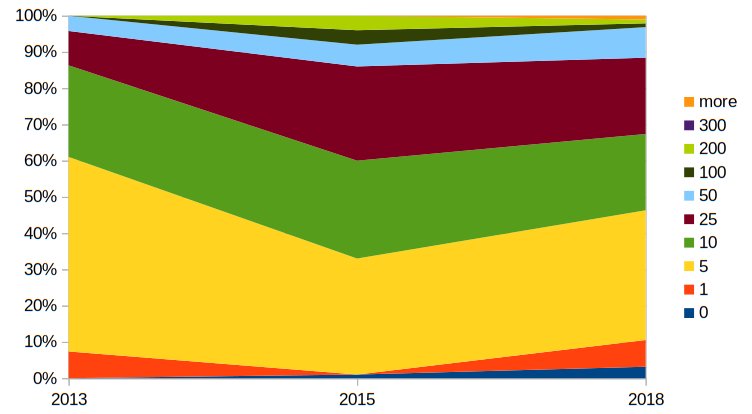
Increasingly users seem to have just a couple repositories or a large number, with the middle ground shrinking. A few percent have 200+ repositories now. The sense is of a split between causual users who perhaps clone one repository to a few places, and power users who are adding new repositories over time.
data stored in git-annex
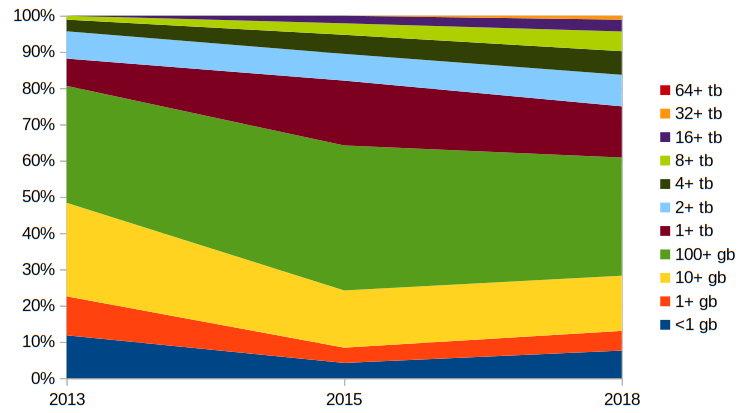
Increasing growth in the high end with many users storing dozens of terabytes of data in git-annex and a couple storing more than 64 terabytes. And a bit of growth in the low end storing under 100 gb.
The total data stored in git-annex looks to be around 650-1300 terabytes now. It was around 150-300 terabytes in 2013. That doesn't count redundant data. And it could be off slightly if shared repositories were reported by multiple users.
(Compare with the Internet Archive, which was 15000 terabytes in 2016 but I think they keep two copies of everything, so call it 7000 terabytes of unique data.)
git level
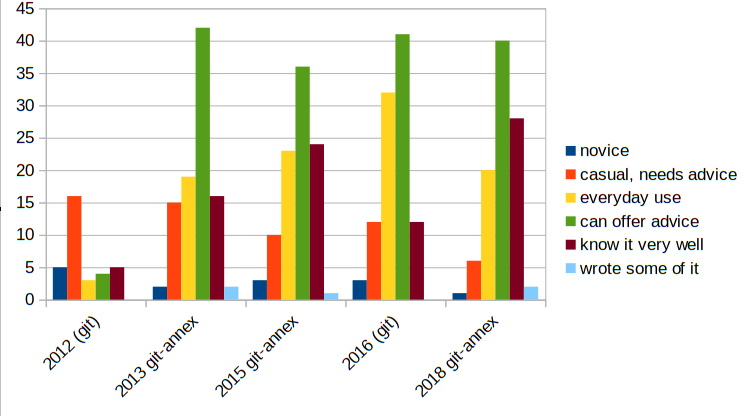
The same question was asked in the git surveys so I have included those in the graph for comparison.
git-annex users trend more experienced than git users, which is not surprising. You have to know some stuff about git to understand why you'd want to use git-annex.
Notice that git knowledge level is generally going up over time in both surveys.
happyness with the software

A similar question on the git survey included for comparison.
There's a bimodal distribution to git-annex user's happyness, with more unhappy with it than with git, but also more so happy they gravitate toward extreme praise.
There seem to be more unhappy users in 2018 than in 2015 though. The 2018 results are very close to the 2013 results.
blocking problems
Notably 15% of users now find git-annex too hard to use, up from 5% in 2015. Which seems to correlate with some users being more unhappy with it. I don't think git-annex has gotten any harder to use, so this must reflect a change in expectations and/or demographics. (2013 had similar numbers to 2018.)
Very few complain about the documentation now, down to 3% from 13% in 2015, but 12% want to see more tutorials showing how to tie the features together.
And a staggering 21% picked a write-in, "no issues personally, but people don't see (or realize they need) the immense benefits it provides". Need to find better ways to market git-annex, essentially.
size of group using git-annex together
A similar distribution to 2015. One person said they're using git-annex in a group of 50+, and 5 reported groups larger than 10 people.
scientific data
A new high of 11% of respondants are using git-annex to store scientific data. (Other kinds of data it's used for seem more or less the same.)
Part of that growth is because of the companion 2018 git-annex scientific data survey which was promoted in some scientific communities, and so brought more scientists to the main survey.

The use for neuroscience is no surprise, but so much use for astronomy and physics is. And "other" in that pie chart includes statistics, social sciences, mathematics, education, linguistics, biomedical engineering, EE, and physiology -- wow!
survey reach
All participants in the science survey did go on to answer at least part of the main survey. So 37% of respondants to the main survey are scientists.
A full 27% of survey respondants have their name on the thanks page, many for financial support. Which is really great, but also speaks to the fraction of the git-annex user base who saw the survey, because I really doubt that a quarter of the users of any free software are financially supporting it.
As with any online survey, the results are skewed by who bothers to answer it. Still, a lot of useful information to mull over.
